Continuely Need to Clean 564xl Print
Z7_3054ICK0KGTE30AQO5O3KA30N0
hp-concentra-wrapper-portlet
![]() Actions
Actions
HP Photosmart 7520 Printers - Black or Color Ink Not Printing, Other Print Quality Issues
This document is for HP Photosmart 7520 and 7525 e-All-in-One printers.
The quality of a printed document or photo is not as expected. The procedures in this document should help with streaked or faded printouts, color or black ink not printing, documents with blurred or fuzzy text, ink streaks or smears, and other print quality problems.
note:Rough handling at the store or during installation can cause print quality problems with newly installed ink cartridges. If you see print problems with newly installed ink cartridges, wait for a few hours for the automatic servicing routine to complete, and then try to print again.
Step 1: Reinstall the print driver (Windows only)
If you cannot print color from a Windows computer, uninstall and reinstall the printer software. Skip this step if your printer is able to print in color.
-
Remove the printer from the devices list.
Try to print. If these steps resolved the issue, you do not need to continue troubleshooting.
Step 2: Use genuine HP ink cartridges
HP recommends that you use genuine HP ink or toner supplies. HP cannot guarantee the quality or reliability of non-HP or refilled cartridges. If you do not use genuine HP cartridges, the steps in this document might not resolve the issue. To check the authenticity of your cartridges, go to the HP anti-counterfeit webpage (in English).
| Americas and Asia Pacific (excluding China, India, and Japan) | Western Europe | Africa, CIS, Japan, and Middle East | China and India | |
| Ink cartridge | HP 564 | HP 364 | HP 178 | HP 862 |
Purchase replacement cartridges and other supplies from the HP Store or local retailers.
If using genuine HP ink cartridges does not resolve the issue, continue to the next step.
Step 3: Allow automatic servicing to complete
Your HP printer has an automatic servicing routine that can solve many print quality issues. There is nothing you need to do. The print quality should improve a few hours after you experience the issue.
If you cannot wait for the automatic servicing routine to complete, continue with the following troubleshooting steps.
Step 4: Check the paper
Make sure the paper is appropriate for the print job. If it is not, reload the printer with an appropriate paper type.
-
Load the paper print side down in the input tray. Many papers have printing and nonprinting sides, such as photo paper and envelopes. Usually, the smoother side is the "print side," and sometimes the non-print side has a logo of the paper manufacturer on it.
-
Do not use wrinkled or curled paper. Use only clean, wrinkle-free paper.
-
Use the correct paper type for your project.
-
For everyday text documents, plain paper with ColorLok technology works well. Paper with ColorLok technology is industry-standard paper that works well with HP ink.
-
For documents with dense printing, such as high contrast graphics or photos, use HP Advanced Photo Paper for best results.
-
Some paper might not absorb ink as well as others. If your prints smear easily, make sure you are using a recommended paper.
-
-
Store photo paper in its original packaging inside a resealable plastic bag. Store the paper on a flat surface in a cool, dry place. Load 10-20 sheets of photo paper only when you are ready to print, and then put the unused paper back in the packaging.
-
Try using a different paper. This determines if the problem is related to the paper.
If changing the paper did not resolve the issue, continue to the next step.
Step 5: Check the print settings
Check the print settings to make sure they are appropriate for your print job.
If changing the print settings did not resolve the issue, continue to the next step.
Step 6: Check estimated ink levels
Check estimated ink levels to see if any ink cartridges are critically low or empty. Ink must be available in each cartridge to run printhead-servicing tasks and prevent nozzles from clogging with ink.
note:Ink level warnings and indicators provide estimates for planning purposes only. When an indicator shows low ink levels, consider having a replacement ink cartridge available to avoid possible printing delays. You do not need to replace ink cartridges until print quality becomes unacceptable.
From the home screen of the printer control panel, touch the Ink icon  . The current ink levels display.
. The current ink levels display.
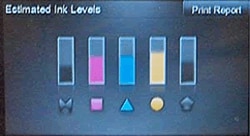
-
If none of the ink cartridges are low on ink, you do not need to replace them yet. Skip to the step to make sure the ink cartridges are properly vented and seated correctly.
-
If any of the ink cartridges are low on ink, continue to the next step to replace them.
Step 7: Replace any low or empty ink cartridges
Replace low or empty ink cartridges.

-
Turn on the printer, if it is not already on.
-
Open the ink cartridge access door.
The carriage moves to the access area.
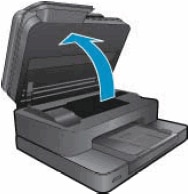
-
Wait until the carriage stops moving before you continue.
-
Press the tab on the front of the ink cartridge inward to release it, and then pull up on the ink cartridge to remove it from the slot.

note:
Never turn off the printer when ink cartridges are missing. Make sure you replace any missing ink cartridges as soon as possible to avoid print quality issues and possible extra ink usage or damage to the ink system.
caution:
Do not lift the latch to the side of the carriage to remove the ink cartridge. Doing so might result in incorrectly seated ink cartridges.
-
Repeat the previous step until you have removed all of the ink cartridges from the printer.
-
Remove an ink cartridge from its package, and then pull the orange pull-tab straight back.
caution:
Make sure you remove the orange pull-tab and plastic wrap completely before you remove the orange cap in the next step. Otherwise, ink might leak from the ink cartridge. When you remove the plastic wrap, the paper label on the top of the ink cartridge tears slightly, which is necessary to properly vent the cartridge.

-
Twist the orange cap counter clockwise until it snaps off the new ink cartridge.
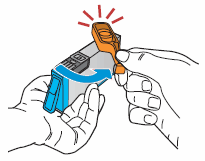
-
With the nozzle and contacts facing down, slide the ink cartridge into its slot. Press down on the cartridge until it snaps into place.
caution:
Do not lift the carriage latch handle to install the ink cartridges. Doing so can result in incorrectly seated ink cartridges and printing problems. The latch must remain down to install the ink cartridges correctly. Make sure the colored icon on the ink cartridge matches the colored icon on the slot.
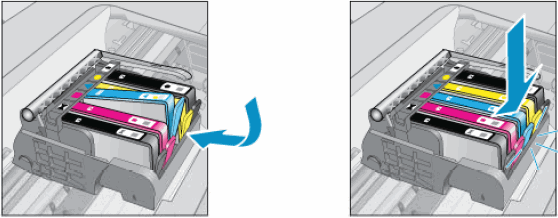
-
If the ink cartridge does not snap into place, remove the ink cartridge from the carriage. Gently bend the tab away from the ink cartridge, and then reinsert the ink cartridge into the carriage.
caution:
Be careful not to bend the tab out more than 1.27 cm (0.5 in). Moving the tab too far might damage the ink cartridge or cause the tab to break off.
-
Bend the tab away from the cartridge
-
Do not bend the tab more than 1.27 cm (0.5 in)
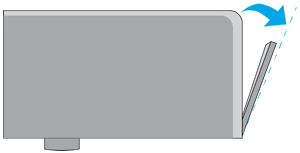
-
-
Repeat the previous steps until you have inserted all of the new ink cartridges into the printer.
-
Close the ink cartridge access door.
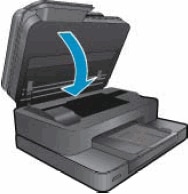
-
When you insert a new ink cartridge, the printer automatically prompts you to align the ink cartridges. Touch OK on the printer control panel to complete the alignment.
If replacing any low or empty ink cartridges does not resolve the issue, continue to the next step.
Step 8: Print a Print Quality Diagnostic report
Print a Print Quality Diagnostic report, and then evaluate the results.
-
Load plain, white paper in the input tray.
-
On the printer control panel, touch the Settings icon
 .
. -
Touch Tools, and then touch Print Quality Report.
The printer prints the Print Quality Diagnostic report.

Step 9: Check the Print Quality Diagnostic report for defects
If the printer and the ink cartridges are working correctly, all the color bars should be complete, unstreaked, and uniform in color across the width of the page. The black text on the page should not have ink streaks.
Review the following table for examples of defects that can exist on the Print Quality Diagnostic report. These examples are not all-inclusive, but tend to represent the most common issues.
| Examples of defects on a Print Quality Diagnostic report | ||
| Defect | Example | |
| Irregular streaks | | |
| Faded color bars | | |
| Missing color | | |
| Color bars with regular white streaks | | |
| Jagged alignment patterns | | |
-
If you do not see defects on the Print Quality Diagnostic Report, the print mechanism and ink cartridges work correctly. You do not need to continue troubleshooting.
-
If you see one or more of these defects on the print quality diagnostic report, continue to the next step.
Step 10: Make sure the ink cartridges are properly vented and seated correctly
If the vent on the top of the ink cartridge is clogged or obstructed, the ink cartridge might not work properly. Follow these steps to make sure the ink cartridges are properly vented and seated correctly.
-
Turn on the printer, if it is not already on.
-
Open the ink cartridge access door.
The carriage moves to the access area.

-
Wait until the carriage stops moving before you continue.
-
Press the tab on the front of the ink cartridge inward to release it, and then pull up on the ink cartridge to remove it from the slot.
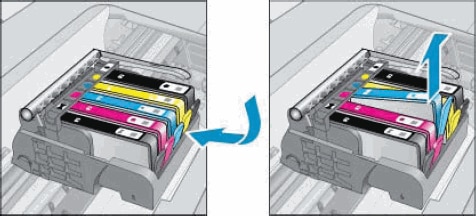
-
Examine the vent area on each ink cartridge, above the HP logo on the top of the ink cartridge.
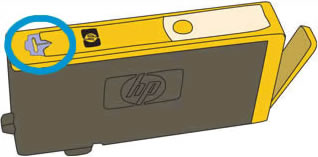
-
If the ink cartridge still has the pull tab attached, pull to remove it.
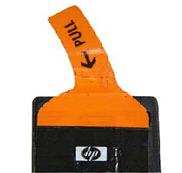
-
If the vent is clogged, use a straight pin to gently remove excess adhesive from the vent.
-
Clogged vent
-
With a straight pin, gently remove excess adhesive from the vent
-
Unclogged vent

-
-
With the nozzle and the contacts facing down, slide the ink cartridge into its slot. Press down on the ink cartridge until it snaps into place. Make sure the color icon on the ink cartridge label matches the color icon on the slot.
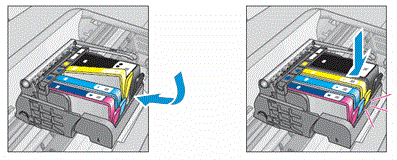
-
Repeat these steps to inspect the vents on each ink cartridge.
-
Make sure each ink cartridge is firmly in place in its slot. Run your finger along the top of the cartridges to feel for any that are protruding, and if any are, press down firmly until each ink cartridge snaps into place.
-
Close the ink cartridge access door.

Try to print. If after making sure the ink cartridges are properly vented and seated correctly does not resolve the issue, continue to the next step.
Step 11: Clean the printhead
From the printer control panel, use an automated tool to clean the printhead.
note:To avoid issues that require cleaning the printhead, always turn the printer off with the Power button on the printer itself.
-
Load plain white U.S. letter or A4 size paper in the input tray, if it is not already loaded.
-
On the printer control panel, touch the Settings icon
 .
. -
Touch Tools, and then touch Clean Cartridges.
The printer cleans the printhead and then prints a test page.

-
Check the test page for defects.
note:
There are three cleaning levels. Complete all three if necessary. If the printhead is badly clogged, it might require another cleaning cycle. If so, wait 30 minutes before you perform all three levels of cleaning again.
Try to print. If cleaning the printhead using the automated tool does not resolve the issue, continue to the next step.
Step 12: Align the printer
From the printer control panel, use an automated tool to align the printhead.
-
Load plain, white paper in the input tray.
-
On the printer control panel, touch the Settings icon
 .
. -
Touch Tools, and then touch Align Printer. After the alignment, a message displays on the printer control panel that tells you the alignment status.
Try to print. If aligning the printhead did not resolve the issue, continue to the next step.
Step 13: Check the printhead warranty status
In general, if your printer is within warranty, so is the printhead. Additionally, if HP has replaced your printhead or if you have purchased a replacement, the replacement printhead is covered under warranty for 90 days, regardless of printer warranty. If you are not sure if your printhead is under warranty, see HP's Warranty Check Tool to determine if your printer is still under warranty or refer to the receipt documentation that came with your replacement printhead.
-
If the printhead is in warranty, contact HP to see if the printer's condition warrants a replacement printhead based on the terms of your product's warranty. Do not continue with these steps if your printhead is in warranty. Skip to the step to service the printer.
-
If the printhead is out of warranty, continue to the next step to manually clean the printhead.
Step 14: Prepare to clean the printhead
Gather the following items:
-
A clean disposable container capable of holding enough water to submerge the printhead
-
Two clean lint free cloths such as coffee filters
-
Filtered or distilled water (tap or mineral water may contain contaminants that could damage the printhead)
-
A pan and stove or other means of heating water
-
Disposable gloves
-
Paper towels
Step 15: Clean the printhead manually
When manually cleaning the printhead, the printhead nozzles are soaked in very warm water for no longer than ten minutes. Use these steps only as a last resort and if the printhead would be disposed of otherwise.
caution:Manually cleaning the printhead should only be performed if the printhead is no longer under warranty.
-
Set the pan on the stove, and then fill the pan with filtered or distilled water.
caution:
Do not use alcohol or other solvents. This might damage the printhead, causing the printhead layers to separate, requiring replacement of the printhead.
-
Heat the water until the water is very warm to the touch, but do not boil the water.
-
Stack the paper towels at the bottom of the disposable container until the stack is about 6.5 mm (1/4 inch) deep.
-
Pour the warm water from the pan into the disposable container so that it is 5 cm (2 inches) deep and covering the paper towels.
-
Put on disposable gloves to prevent ink from transferring to your skin or clothes.
-
Press the tab on the front of the ink cartridges to release them, and then lift the ink cartridges out of the printhead.
note:
Do not leave the ink cartridge outside the printer for longer than 30 minutes. The printhead and ink cartridges can be damaged by being exposed to air outside of the printer.
-
Set the ink cartridges upside down on a paper towel.
-
Lift the latch handle on the carriage until it stops, and then carefully lift up on the printhead to remove it from the printer.
-
Moisten one of the clean, lint-free cloths with some of the warm water and use it to clean the underside of the printhead. Repeatedly wipe the nozzle area gently until excess black or color ink does not transfer to the cloth. Do not press into the nozzle area as this can cause damage.
caution:
Do not force water into the printhead, this can cause printhead delamination.
-
Place the printhead into the disposable container so that the bottom rests on the paper towels, and then let it soak for 10 minutes.
-
Paper towels
-
Water level
-
-
Remove the printhead, and then gently wipe the excess water with a dry lint free cloth.
caution:
Do not use a hair dryer to dry off the printhead. This could cause the nozzles to dry out and clog.
-
Let the printhead air-dry on a paper towel for 15 minutes with the nozzles facing up.
caution:
Do not use compressed air to blow out the printhead. This can cause delamination of the printhead.
-
Lower the printhead into the carriage, and then carefully lower the latch handle.
note:
Make sure the colored shapes on the sides of the printhead line up with the colored shapes on the carriage.
-
With the ink cartridge contacts facing the printhead, slide the ink cartridge into the correct slot. The color-coded icons on the ink cartridge and in the printhead indicate the correct slot.
Press down on the ink cartridge until it snaps firmly into place.
-
Repeat these steps for each ink cartridge.
note:If you encounter the 'Printhead Problem' error message, turn the printer off and on.
The automated printhead cleaning tool must run after manually cleaning the printhead. Continue to the next step.
Step 16: Clean the printhead
After manually cleaning the printhead, use the automated tool to clean the printhead again.
-
Load plain white U.S. letter or A4 size paper in the input tray, if it is not already loaded.
-
On the printer control panel, touch the Settings icon
 .
. -
Touch Tools, and then touch Clean Cartridges.
The printer cleans the printhead and then prints a test page.

-
Check the test page for defects.
note:
There are three cleaning levels. Complete all three if necessary. If the printhead is badly clogged, it might require another cleaning cycle. If so, wait 30 minutes before you perform all three levels of cleaning again.
Try to print. If cleaning the printhead does not resolve the issue, go to the next step.
Step 17: Replace the printhead
If cleaning the printhead did not resolve the issue, order a new printhead from HP or an authorized retailer.
caution:Wait until you have a new printhead assembly available before removing the ink cartridges. HP recommends that you do not leave the ink cartridges outside the printer longer than 30 minutes. This could damage both the printer and the ink cartridges.
-
If you are in Asia Pacific, the site directs you to a service center in your area.
-
Search for printhead number CN642A.
-
Follow the instructions to order the printhead assembly.
Try to print. If replacing the printhead does not resolve the issue, continue to the next step.
Step 18: Service the printer
Service or replace your HP product if the issue persists after completing all the preceding steps.
Go to Contact HP Customer Support to schedule a product repair or replacement. If you are in Asia Pacific, you will be directed to a local service center in your area.
To confirm your warranty status, go to HP Product Warranty Check. Repair fees might apply for out-of-warranty products.
note:Keep a print sample that shows the problem. If the ink cartridges, printhead, or printer is replaced under warranty, the support agent will request the print sample. If the printer is returned to HP, the print sample must be returned with the printer. Place the sample in the output tray when you package your printer for shipping.
Source: https://support.hp.com/us-en/document/c04770092
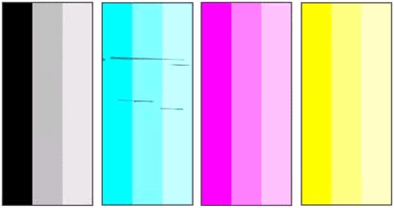

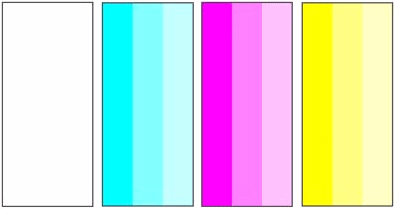
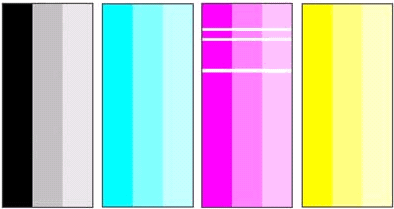

0 Response to "Continuely Need to Clean 564xl Print"
Postar um comentário